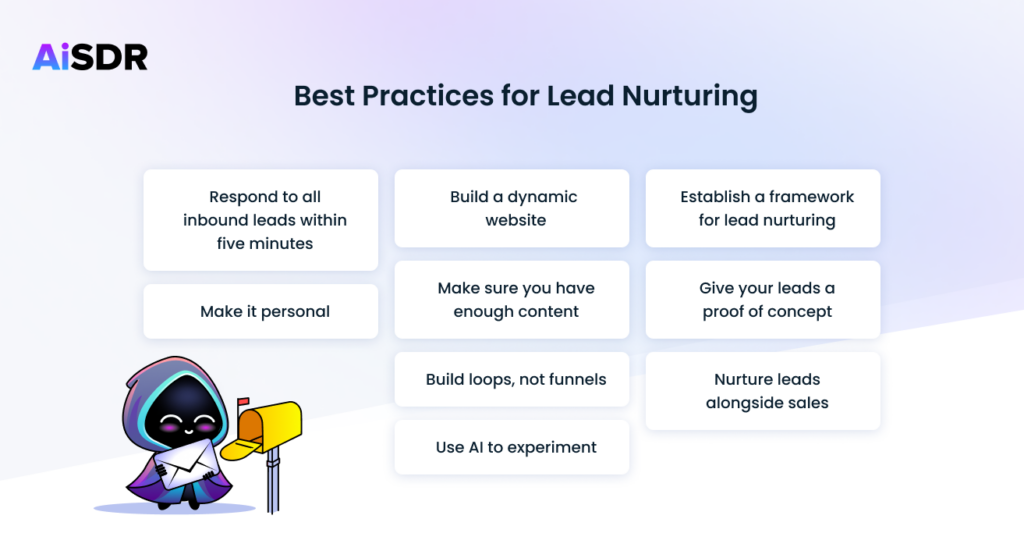Mastering Inbound Lead Nurturing in 2025

Spray and pray’ nurtures are bound to fail. Check out what your leads expect from a remarkable inbound experience
Nurturing is an essential tactic for any company that wants to succeed and grow its bottom line. In fact, according to DemandGen’s 2022 survey of 340 B2B executives, 68% of businesses said a vendor’s knowledge of a prospect’s company and its needs was a top factor in choosing the vendor.
However, nurturing leads has become more challenging than ever due to increased competition for customers and a slowing market. This begs the question: How do you build an effective nurturing strategy in modern economic conditions?
One way is to incorporate AI tools, like the AiSDR AI tool for marketing, to build and execute your lead nurturing strategy.
Here are some of the ways tools like AiSDR can help you solve nurturing problems and optimize workflows.
What is lead nurturing?
When businesses nurture leads, they’re trying to demonstrate their knowledge and understanding of a lead’s needs while gently offering their products as a solution. They often do this with the help of sales and marketing enablement tools like:
Sales representatives nurture leads to convince potential customers (without pressuring) to purchase the company’s products or services. As you can imagine, this isn’t a fast process. However, good, customer-centric nurturing is a proven strategy for boosting conversion.
For example, an approach like “Look at our product. It’s the best on the market, and the price is the best!” doesn’t usually work for most people for two reasons: 1) People don’t like when someone aggressively tries to sell something to them; 2) People can’t see the value.
However, if a company explains how exactly their product can solve problems, people will start to start to consider them. If your leads are plagued by long response times or high administrative costs, your nurturing would focus on those pain points and how your product can ease or eliminate them.
Why is lead nurturing that important?
As nurturing seems like a lot of work and effort, you might wonder whether it’s really that important to pay so much attention to it. After all, if someone shows interest, why bother? But here’s the thing: nurturing plays a key role in transforming this interest into an actual sale by delicately convincing a lead that they actually need exactly your product to fix their problems. And the numbers prove it best.
Lead nurturing statistics
Statistics clearly highlight the importance of lead nurturing. It’s enough to look at some recent figures:
- One of the top challenges 54% of marketers face this year is improving lead quality and conversion rates.
- About 96% of visitors to your website aren’t ready to buy right away.
- Companies that are good at lead nurturing see a 50% increase in sales-ready leads while cutting costs by 33%.
What do these numbers mean? Many companies struggle to turn leads into customers without nurturing because new leads need more information and a gentle nudge to be ready to buy. Businesses that offer this nudge end up closing more deals.
Lead nurturing strategies
There is no perfect approach to nurturing. Different target audiences have unique needs and preferences. In fact, audience over-generalization is one of the most common mistakes when creating sales personas.
That being said, here are some of the most popular strategies for lead nurturing.
Email marketing
Email marketing combined with automation is one of the most popular and effective ways to launch a nurture campaign.
With the help of marketing tracking tools or CRM software, you can define a lead’s customer journey stage and automatically send them the corresponding lead nurturing emails. For example, if a lead views your product page and pricing, you can use lead nurturing software to send them a reminder or a comparison of your products.
Content marketing
Another B2B lead nurture strategy is to provide customers with interesting and engaging content to show the value of your product. Your customer profile and sales persona will help you decide which content to tailor and provide: blog posts, white papers, research, ebooks, guides, and any other useful information to help leads make up their minds.
Social media marketing
Social media is also a great channel to convey your product value, as you constantly emerge in leads’ feeds and, hence, at the top of their minds. By posting relevant social media posts and ads, you start to grow on leads and earn their trust, as well as constantly expand your lead base by reaching new social media users.
Sales calls
Not only are sales calls a classic approach, they’re also a B2B lead nurturing example that’s effective.
Sure, calls aren’t for everyone (especially nowadays), but according to Rain Group research, 82% of B2B buyers accept phone or video meetings when salespeople reach out to them. By calling, you can get answers from leads faster, speeding up your research on defining their pain points, customer journey stage, and prevalent concerns.
Common problems for nurturing leads in 2023
One might think that nurturing inbound leads is a simple job. Why wouldn’t it be if people have already shown interest in your product?
But interested prospects must be wooed into buying, and these days, new challenges faced by marketers and sales development representatives (SDRs) make nurturing leads more complicated than ever.
Let’s take a look at some of the more common problems.

Work overload due to high quotas and understaffing
Only a small fraction of leads become customers (9.8% of landing page visitors, for example), meaning marketers and SDRs must interact with hundreds of prospects to meet sales goals. Plus, most companies can’t afford a big marketing team dedicated just to nurturing leads.
As a result, employees on other teams may have to pitch in and contact dozens of leads on top of their other daily responsibilities. Overworked people can’t provide quality service and pay the personal attention required to get a lead to respond to their efforts.
Difficulties in getting a response
When “Generation Mute” (as millennials have been called due to their preference for text communication over calls) is the primary workforce of any company, it’s more challenging to get a response from a company you’re targeting.
People on the customer’s side can ignore messages and emails more easily than calls. They can also avoid agreeing to take a call before they do their homework by researching your company, your product, and your competitors. A sales team should carefully choose the subject line and messaging so that they attract attention and communicate value. In this way, there’s a better chance of retaining leads.
Recession worries
“Recession” was one of the top buzzwords throughout 2022 and even into 2023. As inflation and interest rates climbed, businesses were increasingly reticent to make any purchases, even essential ones.
Their fears weren’t without reason. Not only are recessions a prolonged period of 2+ consecutive quarters of economic decline, they’re also marked by increased unemployment and economic difficulty.
While the US has managed to avoid a recession so far, economic concerns are continued through the end of 2024, even though Goldman Sachs, one of the world’s leading investment companies, has lowered the odds of a US recession by 5%—to 15%.
If businesses are going to think twice before investing in anything new, marketers and salespeople need to increase their efforts to develop and nurture companies interested in their products.
Longer purchase cycles
Because companies are hesitant to make new purchases, protracted purchasing cycles have become common. In 2022, 50% of DemandGen survey respondents said they extended their purchase timeline compared to 2021. This means marketers and sales reps need to dedicate more resources and time to nurture leads. But extra effort brings us to the next issue.
Market saturation and exploding inboxes
Even though the market is slowing down, competition remains high, which means every company is trying to reach a lead and attract their attention by bombarding them with offers. Every potential customer has many vendor options to choose from, so one small mistake in your marketing can push them toward your competitor.
This leads us to the next frequent issue.
Alligator syndrome
A common mistake of marketers and SDRs is that they talk too much and listen too little. This behavior is what we call alligator syndrome.
When a lead’s constantly receiving pitches, they start to feel like a target. They may even begin to mistrust your company. But if an SDR learns what the lead needs and briefly explains how the product can meet their needs, their trust in your company grows. The client is more likely to buy your product after learning how it benefits them.
Crafting a good strategy for nurturing leads and getting some help from artificial intelligence can overcome these marketing and sales problems. This is where data collection comes in, as it can play a central role in your nurturing strategy.
Data collection essentials to nurture your leads
Nurturing leads is a process of retaining and nourishing a prospect’s interest to the point of selling them something. You can do this by learning their needs and pain points and finding ways to solve them with your product. Specifically, you can nurture their interest by collecting and using all the information you know about the prospect every time they interact with your company.
During the first touchpoint
Figure out how the lead found your company and which content they engaged with.
For example, suppose a person contacts you via Instagram. This gives you plenty of information to start from: social media profiles with personal data that may include their location, demographic information, and even what industry they’re in.
Map this information while using your ideal customer profile and sales persona to forge a path for nurturing the lead.
When leads interact with your content
Tracking visitor activity on your website is essential for the first touchpoint and subsequent interactions. AI-based marketing software can track which articles, landing pages, or ads your lead visited. Knowing what services or blog posts they reviewed helps you better understand their needs and concerns.
Other opportunities to collect data
Instead of interrogating leads, it’s always better to minimize friction using more subtle ways to collect data. For example, offering a form to help a prospect calculate the price of the service they need is a more subtle and non-invasive way to receive basic lead data. Or you can offer a free tool or template that collects leads’ data when they use them.
Hypotheses and assumptions
After collecting all the necessary data, such as the industry, available personal or company details, position, possible budget, needs, pain points, etc., you have everything to design an effective nurturing strategy.
For instance, let’s say you sell helpdesk software. If you know that a lead is looking for a healthcare helpdesk for a small city hospital, you can research what might be their main concerns about purchasing your product — limited budget, patient privacy, or employees’ fear of change — and tackle those concerns before they voice them.
You can send them blog posts about the cost-savings your software will bring or how it complies with patient privacy regulations better than the competition’s.
Data gathering is a time and energy-consuming job. But you can use AI to collect and analyze data within a few minutes. Then, once you have the whole picture, you can define obstacles and solutions more accurately.
Still, data collection isn’t the only thing you should care about. There are several tactics you can employ to boost your nurturing of inbound leads.
B2B lead nurturing: Best practices
To encourage leads to purchase, you must remember every little detail affecting the prospect’s choice and make precise moves along the buying journey. Here are some of the best practices for lead nurturing if you want your efforts to pay dividends.

Establish a framework for lead nurturing
Create a framework to help your sales team work with each new lead in the most efficient way. The framework should include steps of lead nurturing and tools that help with related tasks, from tracking lead activity to personalizing emails.
Nurturing steps can differ depending on the scenario, and the tracking results should guide the sales team’s actions. For example, if tracking results allow qualifying a lead as marketing qualified leads (MQL), the following action would differ from those needed for sales accepted leads (SAL).
To make tracking easier, AI-based lead qualification tools are the best choice. For example, AiSDR can create a suitable nurturing campaign or ask the lead additional questions if there’s insufficient information. But these tools are helpful only if your SDR knows how to use them effectively within the framework created.
Nurture leads alongside sales
Even after passing leads to the sales team, continue nurturing them. Keep the communication going and work with sales to improve it.
Marketers should share a document that has helpful insights they’ve discovered and ideas for countering a prospect’s objections. Lead nurturing with AI makes this work easy: AiSDR software can pull notes from your current research and nurturing efforts to create a comprehensive guide for sales agents.
Respond to all inbound leads within five minutes
According to Xant, conversion rates for inbound leads are eight times higher if you contact them within five minutes compared to longer response times. This means responding to every lead as soon as possible is essential, even if they reach out to you at night.
You don’t need employees working 24/7 to do this, but you must keep leads interested until an agent can answer. This is where AI-based nurture software like AiSDR can come to the rescue!
AiSDR can communicate with a lead just as well as a human during the first stages of nurturing by asking questions, clarifying information, and providing answers to common questions. It can even send helpful content like blog posts.
This way, when an agent gets to work in the morning, they’ll have all the data they need and can pick up the conversation wherever your AI SDR left off.
Make it personal
You’ve heard it a million times, but one more time won’t hurt: Personalize communication with your prospect!
Slamming a first name and company name into a message isn’t enough. You need to know the company’s latest news, messaging, and concerns. With some research, you can find most of this data to use in nurturing emails.
Build a dynamic website
A dynamic website is one of the best ways to make prospects feel welcome. When your lead opens the site to check prices or product features and sees personalized offers and suggestions that address their needs, they feel valued and understood.
The same goes for web forms if you adjust them for leads returning to your website. Instead of asking the same questions as when they first visited, request new information to clarify their needs.
Give your leads a proof of concept
Remember that your leads are even more cautious about buying now than before. They need hard evidence of a product or service’s benefits before purchasing, so give them some.
Although Marketing doesn’t usually have control over creating free trials, marketing teams can provide informative content. Videos with specific use cases tailored to a lead’s industry, interactive point-and-click tours embedded on the website, or online demonstrations of the product’s work are proofs that can persuade more hesitant leads.
Make sure you have enough content
According to a DemandGen survey of 340 B2B executives, a vendor’s content significantly impacts buying decisions for 84% of decision-makers.
Why? Because most people prefer to do research before a meeting or call with a salesperson and learn as much as possible so that they feel prepared.
That’s why you should provide as much consideration- and decision-making-stage content related to your brand as possible. Before the meeting, give answers to most of the questions prospects will have at different stages of the buying decision process, such as product benefits and potential cost-savings. This will gently nudge a lead to proceed with their buyer journey.
Use a lead nurturing CRM and automation
A solid CRM makes sure that no prospect slips through the cracks. With tools like HubSpot or Salesforce, you can easily automate follow-ups, send personalized emails, and set reminders—all with just a few clicks. These systems track every interaction and prioritize leads based on their actions, so you know exactly who’s ready for the next step. Plus, automation takes care of manual tasks like data entry, letting your sales team focus on building meaningful connections with the leads that matter most.
Use AI to experiment
When a human agent processes dozens of personalized emails daily, they can overlook potential messaging opportunities. AI-based marketing tools can make lead-nurturing messaging suggestions that human agents might not have considered. Moreover, tools like AiSDR can help you test nurturing ideas by suggesting the optimal audience, time, and place for messaging without growing the price tag. If the experiment works, you can implement new messaging or practices on a grander scale.
Build loops, not funnels
We all know about marketing and sales funnels, but we rarely stop and think about other effective models.
Building loops may be a more powerful nurturing strategy. That’s because marketers and sales agents must share and add new information about leads to their CRM profiles to build more personalized and effective communication.
This is where a loop can really shine. By continuously gathering feedback each time you make contact, you can adjust the nurturing process and target customers’ needs more accurately.
This way, when you need to extend a customer’s service subscription or sell a new product, you’ll know exactly what to offer and to whom.
Wrapping up
Working with inbound leads is more challenging than ever due to high competition and financial instability. Lead nurturing requires a high degree of personalization, attention to detail, and a deep understanding of customer problems. What’s more, most companies have limited staff and resources, making it challenging to meet these nurturing requirements.
But AiSDR can solve your problems. This AI tool for marketing reduces employees’ time spent on routine tasks by automatically collecting information about leads and helping personalize approaches for each prospect.
Eager to learn more about AiSDR or take it for a spin?
Book a demo to check out how AiSDR will execute your nurturing.
FAQ
What is inbound marketing?
Inbound marketing is a way to attract and engage potential customers through valuable content and experiences rather than directly promoting products or services. For example, by creating a blog post about the business benefits of a CRM system, a company can interest you in purchasing one.
How can email marketing fuel your overall inbound marketing strategy?
Email marketing is crucial for fueling an inbound marketing strategy. Using email, you can nurture leads by delivering targeted content to prospects at different stages of the buying journey. Moreover, email marketing strengthens customer engagement and retention by providing updates, exclusive offers, and relevant content to existing customers.
How can contact segmentation be helpful for lead nurturing?
Audience or contact segmentation helps you improve lead nurturing by breaking your audience into smaller, targeted groups based on their interests and characteristics. By doing so, you can create content and messages that speak directly to each group’s needs.
What is inbound content marketing?
Inbound content marketing is a strategic approach that focuses on creating valuable and relevant content to attract and engage a target audience. The content aims to address the audience’s pain points, answer their questions, and solve their problems.
What are some inbound marketing channels?
Inbound marketing channels include:
- social media
- company websites/blogs
- online advertising
- video sharing platforms
- influencers
- online forums/communities
What is the difference between content marketing and inbound marketing?
Content marketing is about creating and sharing valuable content to attract and engage an audience. Inbound marketing is a broader approach that includes content marketing as its subset, along with other strategies like SEO and SMM, to attract and nurture customers throughout their buying journey.
Which is better inbound or outbound marketing?
Comparing inbound and outbound marketing is similar to comparing apples and oranges. Their effectiveness varies depending on the company and its needs. Both options have their strengths, so combining them in a well-rounded marketing strategy is usually the wisest.











